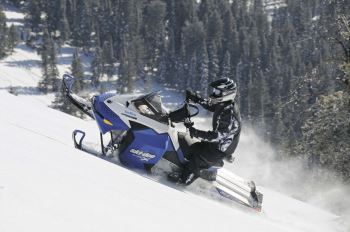 It's one thing to take a class of snowmobiles and run them side-by-side for a few hours to see what feels the best. It's another thing to pound on them for 400 miles in different snow and over different terrain to see what comes out on top.
It's one thing to take a class of snowmobiles and run them side-by-side for a few hours to see what feels the best. It's another thing to pound on them for 400 miles in different snow and over different terrain to see what comes out on top.
This year's SnoWest Deep Powder Challenge took on a different twist by focusing on three stock 800s-the Polaris Dragon, Arctic Cat M8 Sno Pro and the Ski-Doo Summit X. And after 400 miles of trail pounding, boondocking, tree bashing rides, we're still arguing over which of the three is the best all-around mountain sled. Although there may not be an "undisputed" champion of the class, the Ski-Doo Summit X 800 proved to stand out in most conditions for most riders.
Another twist came from what was missing from this year's Deep Powder Challenge. that would be both the deep powder and the challenge. First the deep powder: Since the snow quit falling for the first three weeks of January in our area, we were forced to find most of our powder riding in the trees and east-facing slopes-places most snowmobilers bypass. We did manage to find a lot of unmarked snow, but for the most part it had a decent base to it. And with any kind of base, the 800cc mountain sleds can go about anywhere.
As for the challenge: We knew going into the event that we needed to do something other than have uphill drag races. If the event is limited to a three-day period as in the past, you're 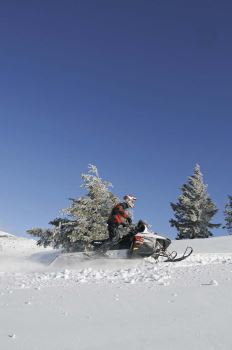 dependent on the weather you get for those three days. If you don't get fresh snow, you don't have challenging powder. And we didn't want to bring in snowmobile dealers from across the West only to watch sleds race up steep slopes, especially with the avalanche conditions that have prevailed early this winter.
dependent on the weather you get for those three days. If you don't get fresh snow, you don't have challenging powder. And we didn't want to bring in snowmobile dealers from across the West only to watch sleds race up steep slopes, especially with the avalanche conditions that have prevailed early this winter.
We had the three 800s in our own fleet, all being bone stock since day one (so there could be no accusations of cheating). Our testing period could be extended from three days to over three weeks, opening up the opportunity of more diversified snow conditions. And we could bring more opinions into the mix. We used nine different riders so we could get nine different opinions.
So in a nutshell, our evaluations of the Summit 800 X, 800 Dragon and M8 Sno Pro extended over three states, on rough trails, through thick trees, across open meadows and up steep mountains. We rode both day and night. We raced and we chased. We tested their turning radius, fuel economy and headlight effectiveness. We used hard-core riders and "wannabe" riders (who get out about once a year).
We tried to be fair and thorough. You'll have to decide what weight to put on each batch of results. But here's how we called it.
Powder Boondocking
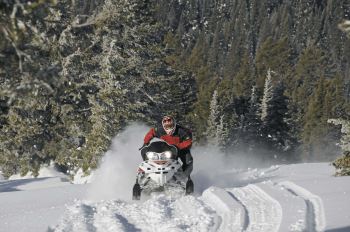 On Jan. 6 a good storm moved through the eastern Idaho highlands and into Alpine, WY. High winds brought blizzard conditions to the Bone area east of Idaho Falls, accentuated with drifting snow and limited visibility. It wasn't a good day for riding . but it was still better than being stuck in the office. The riders for that day were Ryan Harris, Lane Lindstrom and Steve Janes.
On Jan. 6 a good storm moved through the eastern Idaho highlands and into Alpine, WY. High winds brought blizzard conditions to the Bone area east of Idaho Falls, accentuated with drifting snow and limited visibility. It wasn't a good day for riding . but it was still better than being stuck in the office. The riders for that day were Ryan Harris, Lane Lindstrom and Steve Janes.
Once we climbed elevation and made it to an area called Brockman, about 30 miles west of Alpine, the drifting snow accumulated into about two feet of fresh powder. The groomed trail was covered with so much fluff that it became non-existent. We had three sleds creating three tracks as we raced toward Alpine on a 125-mile round trip.
Visibility across the open meadows was restricted-we were basically riding between the trail markers with little or no definition in the snow. Hitting the drifts and wind holes was a true adventure. It made each of us dependent on the handling characteristics of whatever sled we were on at the time. (On all rides, we often rotate through the three models so we can get immediate impressions of what we like and what we don't like.)
In the trees, the snow was deep. Even on a groomed trail you would have a two-foot trench from the sled in front of you. The closer we got to Alpine, the heavier (wetter) the snow got, getting almost slushy the last 10 miles or so. So we went from hard wind drifts to deep fluff to wet heavy snow and then back again.
Here's how we scored the sleds.
Ryan-1-Cat, 2-Polaris, 3-Ski-Doo
"Cat and Polaris are `roll and go' sleds, where you change directions by laying them over and gassing it. The Ski-Doo is more of a steer sled-you have to drive it where you want to go. I find myself taking easier lines on the Ski-Doo than I would on the M8 or Dragon. The Cat handled best 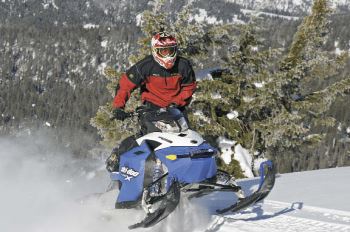 on the twisty trails, but you had to move the telescoping handlebar system down in order to make it turn. Maybe that's why it has an advantage. Getting the bars lower gives you a lower cg over the inside ski. The Polaris' wide handlebars were a stretch. But the Polaris was the easiest to manipulate in heavy powder. Not because the Cat was harder, but because the Cat would get the heavy snow lodged in its steering system and pretty much lock you into autopilot. The Ski-Doo was fun to ride in these conditions . but it was always an argument between it and myself on what lines we were taking. I'm such a pushover." RH
on the twisty trails, but you had to move the telescoping handlebar system down in order to make it turn. Maybe that's why it has an advantage. Getting the bars lower gives you a lower cg over the inside ski. The Polaris' wide handlebars were a stretch. But the Polaris was the easiest to manipulate in heavy powder. Not because the Cat was harder, but because the Cat would get the heavy snow lodged in its steering system and pretty much lock you into autopilot. The Ski-Doo was fun to ride in these conditions . but it was always an argument between it and myself on what lines we were taking. I'm such a pushover." RH
Lane-1-Polaris, 2-Ski-Doo, 3-Cat
"Polaris has the best suspension, best seat and best steering. Cat's seat is too slick and low. Ski-Doo's seat is too sticky and wide. Cat's good in the powder, but not on the trails. It's hard to turn left. It was a struggle trying to find a good position for the telescopic bars. The Ski-Doo felt like I was plowing. And the throttle pull is very heavy." LL
Steve-1-Ski-Doo, 2-Cat, 3-Polaris
"When you're limited in visibility due to light conditions or drifting snow, it's nice to have a sled that's stable and predictable. That's what you get on the Ski-Doo. The Polaris tends to over-react to quick movements. The Cat is slow to react. The Ski-Doo stays flat and level. Polaris does have a great suspension for the bumps, but it's hard to work both sides of the sled when the terrain changes so quickly. The Cat's low seat tends to put you a half step behind the reaction curve. Turning left on an off-camber hill can be quite challenging for the Polaris because it's such a long stretch to reach the throttle. The Cat offers the best approach to kneeling on the seat, allowing for your legs to rest while remaining upright." SJ
First Round Score-Split decision. We have different riding styles and each like different things. When it comes to reliability, the Cat and Ski-Doo made the round trip on their own power. The Polaris had some electrical issues and spent the last 10 miles attached to a tow strap (and the next six days in the dealership).
Powder Mountain
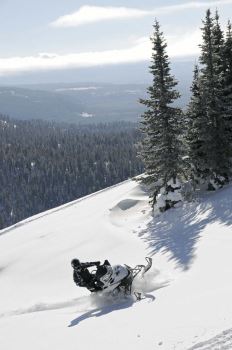 Three weeks later we had another big storm put down about two feet of dry powder in the higher elevations. With extreme cold temperatures, we bundled up and headed for an area called Red Butte east of Rexburg, ID.
Three weeks later we had another big storm put down about two feet of dry powder in the higher elevations. With extreme cold temperatures, we bundled up and headed for an area called Red Butte east of Rexburg, ID.
The riders for this outing were Janes, Jacob White and Brent Purcell.
To get to the high elevation, you have to ride a groomed trail about 15 miles in. This gave us another chance to see how the sleds handled the trails and the cold.
Again, depending on rider preference, all three sleds tend to do well on good trails. Cat provided the best protection from the wind . and Ski-Doo provides very little. This is a cold sled on a cold day.
Once we got back into the steep and deep, it was time to turn the sleds loose on the powder.
For White, the Polaris matched up well with his riding style. "I can lay it over with ease, hold a sidehill and feel confident pounding the trails hard," he explained. "The suspension is predictable, which makes me comfortable riding it harder than the other 800s in the class. I know how it's going to react."
White acknowledges that the Ski-Doo is right at home in the soft powder. "Of all the strengths the Summit has, moving slow through the trees and crawling through powder is its best," he says. "The Ski-Doo just has a way of staying on top the other two 800s don't. I still have a hard time riding the chassis, however. I just can't figure out how to maintain a sidehill or carve on the Ski-Doo. The feedback I get from the sled tells me it likes to have both skis on the snow at all times."
As for the Cat, White said he's amazed how much a new track and tunnel design can improve deep powder ability.
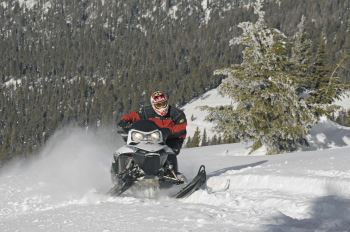 "On any given day, I'd be happy to ride the M8," he says. "It handles well on the trails. Drop the bars as low as they'll go, sit low on the seat and rail it through the corners. Bring the bars back up some and you have complete control in the deep powder. The chassis feels nimble and reacts to every touch from the rider."
"On any given day, I'd be happy to ride the M8," he says. "It handles well on the trails. Drop the bars as low as they'll go, sit low on the seat and rail it through the corners. Bring the bars back up some and you have complete control in the deep powder. The chassis feels nimble and reacts to every touch from the rider."
For Purcell, the Ski-Doo was much easier to handle in the powder.
"When working our way through the trees in the deep powder, I was most comfortable on the Ski-Doo," he explained. "The throttle had the most response, taking me from tree to tree and helping me pick my lines."
Although the Polaris handled well on the trails and was quick in the trees, it wasn't as consistent as the Ski-Doo. The Cat was also effective in the trees, but felt just a little heavy in the powder.
For Janes, the Ski-Doo offered the most stability and control while carving through the trees and holding a sidehill. "The challenge is getting the track set when turning," he explained. "I'm not as young as the others and I don't react as fast as I used to. So I need to be able to crawl through technical spots, and when I hit the throttle, I need the sled to respond instantly and jump right on top of the snow."
Although the Polaris lays over with ease, allowing you to cut into the hillside, sometimes it's just too quick to react.
"I find myself over-steering in technical spots," he explained. "It's more with my riding style . but when I lean hard into a hill and push the running boards into the snow, I end up pushing the sled right out from under me."
Second Round Score-Ski-Doo (because of stability in deep snow in the trees).
Extreme Boondocking
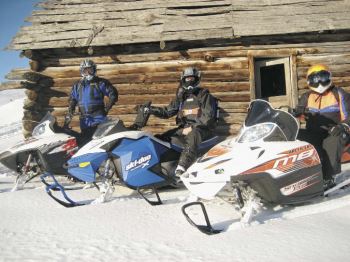 On Jan. 16 (and no additional snow accumulation) we headed out for some extreme boondocking. This means more trees, more sidehills and more finesse. We may have not had any new snow, but the areas we rode had no tracks. (It's funny how you can always find places that others won't ride.)
On Jan. 16 (and no additional snow accumulation) we headed out for some extreme boondocking. This means more trees, more sidehills and more finesse. We may have not had any new snow, but the areas we rode had no tracks. (It's funny how you can always find places that others won't ride.)
On this ride, we started at the dam on Palisades Reservoir and headed southwest over Poker Peak, Jensen Creek, McCoy Creek and to Caribou Mountain. The first 10 miles you're pretty much confined to the trail because of the terrain. It was a cold morning . and with the cold air sitting on the lake, you couldn't find enough protection from the elements. Once we got away from the lake, we could start cutting over ridges as we paralleled a groomed trail. We spent most of the time either up on a sidehill above the trail or down on a sidehill below the trail.
Riding that day were Ryan Harris, Steve Janes and John Summers (your Klim guy). It was a cold but sunny day. We put on 70 miles, but more interestingly, we sort of evolved to the sled we were most comfortable riding under the conditions.
We all started out on a rotation that would put us on each of the three sleds. Nobody liked the Ski-Doo in the cold because it offered the least amount of protection from the elements (and boy your hands can get cold awfully fast). The Cat had great protection, but the rear suspension beat us up in some of the deep moguls as we worked our way through popular riding areas (read: one-line access up through trees) to the undisturbed areas (read: where nobody in their right mind would even try to ride).
With Harris leading the way, you can bet there would be plenty of long sidehills through trees and down deep canyons. This made for lots of off-camber turns and tight, steep sidehills. Both Harris and Summers found the Ski-Doo a hard sled to control under these conditions. But when it came to climbing up through the trees over deep snow and downfall timber, it was hard to beat the Ski-Doo's ability to keep climbing in the worst conditions. Even the Cat had tendencies to handle better while climbing over logs and powering through buck brush than the Polaris.
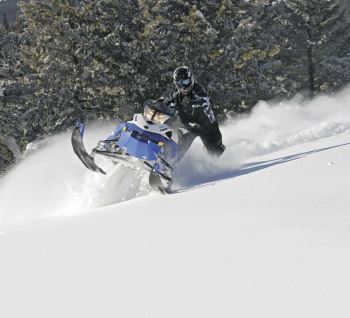 Midway through the day, the three riders migrated to the sled most suitable for their riding style. Harris was on the Polaris, Summers was on the Cat and Janes was on the Ski-Doo. And each of the three seemed more comfortable with the technical style riding required from the terrain.
Midway through the day, the three riders migrated to the sled most suitable for their riding style. Harris was on the Polaris, Summers was on the Cat and Janes was on the Ski-Doo. And each of the three seemed more comfortable with the technical style riding required from the terrain.
Some of the ridges we dropped off into deep, tight canyons were quite intimidating. One in particular dropped straight down into a creek. It was so gnarly that even the sun doesn't like to go down in there. The snow was dry and deep, making it difficult to do much other than grab the throttle and pick your line, hoping the smaller trees and branches would yield to your efforts. Sometimes they did, sometimes they didn't. That's why we carry saws.
Even though it was a cold, tight canyon, we all seemed to work up a pretty good sweat. (Summers was sweating whether he would ever see his wife and kids again.) This was an area where five years ago you would be spending the night. But on that day, we were just making the three 800s earn their keep. "The Ski-Doo probably had the best throttle response out of the three sleds," Summers explained. "It is very snappy and seems to hold that power through the whole range. The Polaris had great throttle response as well and carried that power all the way to the top. The M8 seemed to be a little more sluggish coming out the gates."
Summers said the Ski-Doo's suspension had the ability to make the roughest terrain turn into butter. "It gives you a lot more confidence with the terrain gets gnarled up. The Polaris was harder to point in the direction I wanted to go. It seemed like it almost responded to quickly and would over shoot the direction I want to go. I also noticed that the body roll was more sever," he said.
"I felt like out of all of the sleds the M8 could get you places more predictably and with less fatigue. When having to put the sled on its side the M8 felt like the balance point on the sled is a mile wide," Summers said.
Third Round Score-Another split decision, although Harris could be influenced to go along with Summers on picking the Cat as the best ride of the day in some of the more extreme conditions. Janes will stick to the Ski-Doo on this ride.
Intro Riders
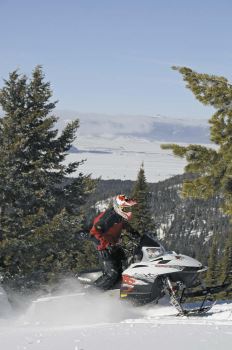 We're always talking about what's the best sled for hardcore snowmobilers. But what about those who don't get out as much or are still looking for a sled that fits their own riding style?
We're always talking about what's the best sled for hardcore snowmobilers. But what about those who don't get out as much or are still looking for a sled that fits their own riding style?
On Jan. 20 we decided to take our three SnoWest salesmen (Gregg Manwaring, Dean Cowley and Mark Evans) out on a ride. These are three guys who ride . but not so often and not on any particular brand (read: whatever sled they can beg, borrow or steal). The idea was to find out what sled they would be most comfortable on in a variety of conditions.
Again, we picked a perfect day. The sky was blue, the temperatures in the mid 20s, but there hadn't been fresh snow for several weeks. We headed down the trail from Bone, traveling east toward Brockman. (We remembered how good the snow was there from two weeks prior. And we knew we could always find areas back in that country where the snow was unmarked.)
The ride itself covered more than 70 miles-the first and last 15 on a groomed trail and the middle 40 cross country. We avoided the more technical areas, although we did ride the trees and some creek drainages (there's nothing like dumping a salesman into an open creek).
Here's how the three somewhat "non-professional" riders rated the 800s (for what it's worth).
Trail Riding-1-Cat, 2-Polaris, 3-Ski-Doo
"I like the height of the Ski-Doo seat and the handlebars are comfortable. The Ski-Doo was more responsive on the trail. The Arctic Cat seat is too low ... but I did like the adjustable handlebars. The Polaris handlebars don't fit me. The Polaris worked well on the trail but the other two sleds were more comfortable to me." GM
"Polaris had good handling and stability with a very nice ride. I like the seat height and width. The windshield was very effective. Cat offered good handling and control. It had an effective powerband and a fairly smooth ride. The Ski Doo has a nice ride but was a little jerky on a hard packed trail and a little tippy on tight curves. The windshield was ineffective. I felt the need to hold on tighter and duck to stay out of the wind." DC
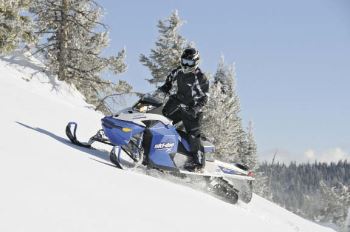 "The Arctic Cat held the trail better at higher speeds. The Polaris featured the best seat comfort and instant power. The Ski-Doo makes you feel every bump in the trail like you were sitting on top of the suspension." ME
"The Arctic Cat held the trail better at higher speeds. The Polaris featured the best seat comfort and instant power. The Ski-Doo makes you feel every bump in the trail like you were sitting on top of the suspension." ME
Bumps and Moguls-1-Ski-Doo, 2-(tie) Polaris, Arctic Cat
"The Ski-Doo felt more comfortable, which made it easier to ride when handling moguls and bumps. I also liked the smooth throttle, although it's a harder pull. The Arctic Cat has a nice ride and handled the moguls and bumps well but the lower seat required more effort in standing and sitting. The Polaris was not as comfortable (due to the handlebars) to ride for me which made it more difficult to handle moguls and bumps." GM
"The Ski-Doo seemed to suck up the bumps and whoops remarkably well and gave me an `I'm in control' feeling. The suspension was very comfortable and easy to handle. Cat offered decent control but was a little rough through the bumps. Polaris seemed to be harder to control in the uneven bumps and was a rougher ride." DC
"Polaris absorbed a lot of the pounding through suspension and seat comfort, but the Ski-Doo was great at powering over the moguls. The Cat has a smooth suspension but lacked some bottom-end response." ME
Powder-1-Ski-Doo, 2-Cat, 3-Polaris
"The Ski-Doo was a pleasure to ride in the powder, seemed easy to handle. Also, the Cat is fun in the powder but the low seat wears me out when standing and sitting so much. The Polaris wears me out because the throttle seems stiff which made it harder to maneuver and the handlebars were awkward." GM
"I felt totally in control in powder conditions on the Ski-Doo. It is very easy to put the sled where I wanted it to go. It felt like I was floating in control rather than pushing the sled where I needed to be. The Cat has a nice powerband for feathering the throttle in more delicate situations. I never felt out of control or out of power. The Polaris was more work than the others to ride in powder. It took more body English to go where I wanted. I want to play in the snow, not work." DC
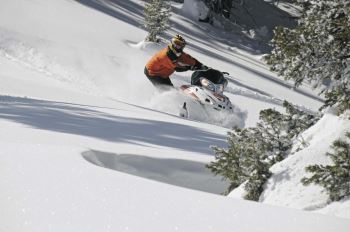 "The Ski-Doo cuts through the powder with little effort. The Cat had more turnability, in part due to its high-rise handlebars. The Polaris has plenty of power but lacked some maneuverability and turning." ME
"The Ski-Doo cuts through the powder with little effort. The Cat had more turnability, in part due to its high-rise handlebars. The Polaris has plenty of power but lacked some maneuverability and turning." ME
Sidehilling-1-Ski-Doo, 2-Cat, 3-Polaris
"The Ski-Doo and Arctic Cat were easy to handle. The Polaris was harder to handle on a sidehill. I don't know if it's the weight or handlebars or both." GM
"Sidehilling (the Ski-Doo) was relatively easy at all times, little effort was needed to make this sled do what I wanted it to do; a real pleasure to ride. Also, the Cat offered good maneuverability and was simple to control. For the Polaris, sidehilling in a straight line wasn't bad, but trying to maneuver while sidehilling was not a pleasant experience . it took the fun out of it." DC
"The Ski-Doo was the easiest to lean and turn. The Cat had good handlebars, while the Polaris narrow seat is nice, but was harder to get on its side." ME
Tree Riding-1-Ski-Doo, 2-Cat, 3-Polaris
"The Ski-Doo fits me best which makes it easy to manipulate in the trees. I would say the Cat was just as fun in the trees as the Ski-Doo, but the low seat takes more effort when standing and sitting. The Polaris has a quick throttle that makes it harder to operate in the situations where you need light touches on the throttle." GM
"I loved the Ski-Doo in the trees-winding, snaking and taking on obstacles was a sheer pleasure; a very fun ride. Arctic Cat had good maneuverability and was fun to ride and play on. It offered good control going downhill in the trees. Polaris was work, work, work. This sled was too much work to push around and manhandle in the trees. I would rather not ride the trees than work that hard to have fun or get to my destination." DC
"Ski-Doo turned on a dime through the tight stuff." ME
Protection from the elements-1-Cat, 2-Polaris, 3-Ski-Doo
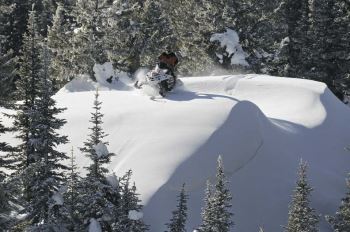 "The Polaris has a nicely profiled windshield and provides great protection from the wind; there was no effort to hold on at higher speeds. The Cat also had decent wind protection for the size of the windshield. But the Ski-Doo-no protection from the wind, whatsoever. You might as well not even have one. It took effort to hold on at higher speeds, not so fun. On a real cold day, it's wicked." DC
"The Polaris has a nicely profiled windshield and provides great protection from the wind; there was no effort to hold on at higher speeds. The Cat also had decent wind protection for the size of the windshield. But the Ski-Doo-no protection from the wind, whatsoever. You might as well not even have one. It took effort to hold on at higher speeds, not so fun. On a real cold day, it's wicked." DC
Seat-1-Polaris, 2-Ski-Doo, 3-Cat
"I liked the higher profile and narrowness of the Polaris. It is a very comfortable ride. The seat height gave extra control for maneuvering the sled. The Ski-Doo has a nice height and comfortable ride. The Cat seat is too low. I felt I had to work around my knees while in the seated position. It is hard on the thighs and knees going from the seated position to the upright position with a full day of riding." DC
Handlebars-1-Cat, 2- Ski-Doo, 3-Polaris
"I like the adjustable handlebars on the Cat. Yet, the position of the Ski-Doo handlebars fit me well. As for Polaris, I'm not certain if the handlebars are wider and taller than others . but it seemed like that to me." GM
"The width and height of the Ski-Doo handlebars were very comfortable for all styles of riding. The Cat's adjustable height was awesome and so easy to use it made it very nice in all riding conditions. The Polaris handlebars seemed wider and took more effort to steer the sled. My upper arms and shoulders got sore fast riding this sled. The hooks at the end of the bars were very helpful for sidehilling." DC
High Speeds-1-Ski-Doo, 2-Cat, 3-Polaris
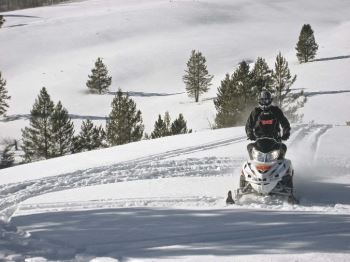 "Arctic Cat has a comfortable ride and a windshield that protects you. The sled handles well on the trail. The Ski-Doo handles well on the trail, which makes it easier to travel at high speeds. But this sled is cold on a trail. The Polaris handles well on a trail but not as well as the other two. This sled is also cold on trails." GM
"Arctic Cat has a comfortable ride and a windshield that protects you. The sled handles well on the trail. The Ski-Doo handles well on the trail, which makes it easier to travel at high speeds. But this sled is cold on a trail. The Polaris handles well on a trail but not as well as the other two. This sled is also cold on trails." GM
"The control of the Polaris was not an issue-nice ride and good wind protection. The Cat was fairly easy to control and felt stable; the wind protection was okay. The ride of the Ski-Doo was very smooth at high speeds on a bumpy trail . but the steering was a little squirrelly at times, kind of jerky." DC
"The Cat held the trail and was smooth at the same time. The Ski-Doo was smoother at higher speeds than at lower speeds. The Polaris had the loudest engine noise and was a little squirrelly at higher speeds." ME
Fun Factor-1-Ski-Doo, 2-Cat, 3-Polaris
"The Ski-Doo handles well in powder and on the trail. It has a smooth throttle. The Cat also handles well in the powder and on the trail, but the low seat is the only draw back. Polaris is too hard to handle in the powder." GM
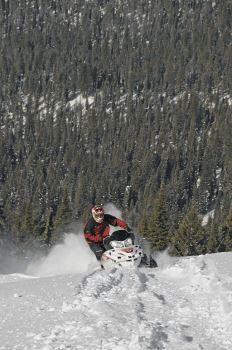 "I love the Ski-Doo overall. It's a little heavy when you get stuck . but control in the mountains is not an issue. This was a very fun sled to ride. I was not worn out after riding this sled all day. The Cat was also a very nice sled, fun to ride and play on all day long. The Polaris was much more work to ride. It is harder to pull over when sidehilling, harder to control when boondocking and just wore me out in a hurry. However, it did pull out of the deeper snow pretty easy." DC
"I love the Ski-Doo overall. It's a little heavy when you get stuck . but control in the mountains is not an issue. This was a very fun sled to ride. I was not worn out after riding this sled all day. The Cat was also a very nice sled, fun to ride and play on all day long. The Polaris was much more work to ride. It is harder to pull over when sidehilling, harder to control when boondocking and just wore me out in a hurry. However, it did pull out of the deeper snow pretty easy." DC
"Ski-Doo felt lighter on the snow, great in powder and very maneuverable. Polaris had great power and the narrower seat helped in maneuvering. The Cat is a great sled for trails and some straight up hillclimbing." ME
Fourth Round Score-We have to give this one to Ski-Doo.
Head-To-Head
Getting riding impressions may be one thing . but how do the sleds compare when lined up against each other?
On Jan. 22-23, we took a couple of days to pull out the stop watch and the radar gun to see exactly what sled can cover a distance the fastest. The most relevant of the tests is our hillcross-a half-mile course climbing 500 feet in elevation (starting at 7,200 feet elevation) up a 27-degree slope with off-camber turns, wind drifts and loose snow. The three sleds were all ridden by the same rider, Ryan Harris.
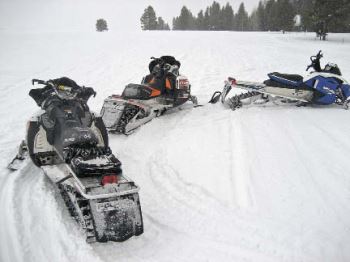 Hillcross-In nine runs, there was only 1.5 seconds between the fastest and slowest runs. The Cat turned in the best time (69.59 seconds), followed by the Ski-Doo's 70.0 seconds. Cat's average time on the three runs was 1:10.71, followed by Ski-Doo's average 1:11.23 and Polaris' average time of 1:11.47.
Hillcross-In nine runs, there was only 1.5 seconds between the fastest and slowest runs. The Cat turned in the best time (69.59 seconds), followed by the Ski-Doo's 70.0 seconds. Cat's average time on the three runs was 1:10.71, followed by Ski-Doo's average 1:11.23 and Polaris' average time of 1:11.47.
As far as rider impressions: "The M8 was all over the place in the rough spots. It would ricochet off the wind drifts. But it would also correct more quickly than the other two, which I think helped it make up time lost in the bumps. The track hooked up better in the softer snow than it did on the hard packed start. The M8 would wear you out trying to control it over the bumps.
"The Dragon was slowest off the line and out of the corners. Its track would spin where the other two tracks would hook up. The Dragon was easy to handle through the deep moguls, but you couldn't pop it into the air or lift the skis to carry the nose like the other two. The Dragon didn't make you as tired as the others.
"The Summit was the best through the rough sections, but worst in the corners. And the flimsy sidehill strap made the off-camber sidehills more of a struggle than the other two. The Summit's hard-hitting power was a blessing in the moguls and a curse coming out of corners. Arm pump was more severe following the Summit's runs. The Summit was the hardest to correct if it got off course, but the least likely to get thrown off course in the first place because it tracked so straight through the rough holes. The Summit's steering would wear you out in the corners and on off-cambers." RH
Hillclimb-Using the Stalker Radar gun and laptop computer, we were able to find a couple of slopes that had untracked, yet somewhat based, snow where we could run some side-by-side climbs. The slope was about 33 degrees with the starting elevation at 7,350 feet climbing up to 7,670 feet on a south-facing slope.
We started the sleds on the slope in soft, fresh snow.
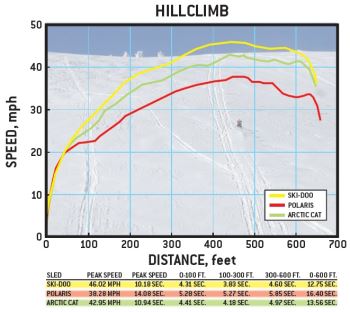 The Ski-Doo and Cat hooked up hard and picked up speed immediately. The Polaris had a tendency to spin a little more out of the hole, falling about a half-second behind in the first 100 feet.
The Ski-Doo and Cat hooked up hard and picked up speed immediately. The Polaris had a tendency to spin a little more out of the hole, falling about a half-second behind in the first 100 feet.
Although the Ski-Doo covered the distance in the fastest time on two different areas (with the tests being conducted twice in each location), the Cat's times pretty much stayed right on top of the Ski-Doo. (See the charts for detailed information.)
Speed Run-Again using the radar gun and laptop, we measured how the three sleds could cover 1,400 feet across a meadow at 6,600 feet elevation. Averaging four runs from each sled (throwing out any run that wasn't consistent with the others), Jacob White was the test rider for all the runs.
"Out of the hole, the Ski-Doo feels the strongest; snappy acceleration, bites hard. Second is the Polaris, but it spins more than the Ski-Doo and doesn't transfer as well. The Cat seemed a little more boggy on the holeshot but pulls up to rpm quick and continues to pull up to top speed." JW
Just for those curious about what we were pulling for rpm, the Ski-Doo was turning 8100 rpm, the Cat 7800 rpm and the Polaris 8150 rpm. (See the charts for detailed information.)
Fifth Round Score-This is a toss-up between Ski-Doo and Arctic Cat.
In The Dark
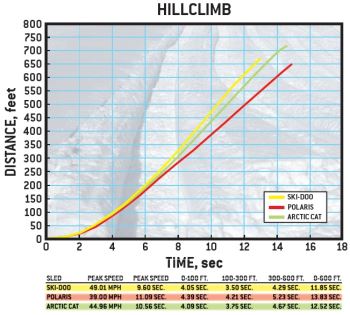 Something that we often overlook is how the snowmobiles deal with darkness. Obviously, just like adjusting suspension, you can adjust the headlights. But we wanted to see if one sled had an advantage over the others when it came to lighting the way after the sun goes down.
Something that we often overlook is how the snowmobiles deal with darkness. Obviously, just like adjusting suspension, you can adjust the headlights. But we wanted to see if one sled had an advantage over the others when it came to lighting the way after the sun goes down.
Test riders were Steve Janes and Jacob White. We took a five-mile loop that included part of the Sawtell Trail, part cross country and part ungroomed trails, to see how the lights affected the sled in various conditions. We took three loops, each aboard a different sled, so we could evaluate each sled's effectiveness.
The Polaris lights where very good once we got them adjusted. (Apparently during the course of the winter, the adjustment dial must have been moved inadvertently, directing the light beam straight up. This would be good if you were hunting possum . but didn't quite work while racing down a trail.)
Cat's lights actually picked a good spot about 20-30 yards down the trail and allowed you to see about the right distance ahead. Whether on the trail or cross country, the Cat's headlight gave you a feeling of confidence that you knew what was coming up.
Although the Ski-Doo lights provided plenty of illumination, they tended to bounce around the most and caused almost a glare because of all the movement. This has a tendency to cause lots of shadows bouncing around, perhaps questioning your confidence on how big the bumps really are.
Along with the headlights, we had a chance to test the comfort and control of the suspension and protection from the elements that complete a night ride.
On the trail, the Polaris tends to handle all conditions either best or near best. The sled is predictable in the bumps, although not always the smoothest. Here the tall seat works a little against you. Usually at night you aren't riding quite as aggressively because of the limited visibility and have a tendency to want to sit and relax. The tall seat exposes you to the elements a little more and isn't the most comfortable. Also, the location of your headlight and handwarmer switches is terrible for night rides.
The Cat was good in the tight turns, mostly because the seat is lower and allows you to keep a low center of gravity . but you tend to feel every bump. The Cat offers the most protection from the cold night air. And the handwarmer and headlight dimmer controls are probably the most user-friendly.
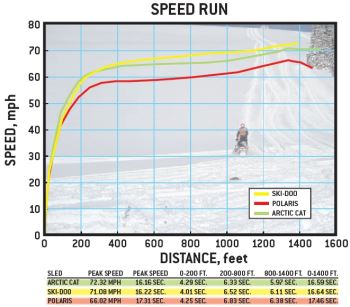 The Ski-Doo eats up the chatter bumps at high speeds. But when you're on and off the throttle, there is too much weight transfer. Corners are bad with too much ski weight going in and not enough coming out. The skis and bars wander and steering seems unpredictable. And there is no wind protection with the hood/windshield. You are definitely more exposed to the elements.
The Ski-Doo eats up the chatter bumps at high speeds. But when you're on and off the throttle, there is too much weight transfer. Corners are bad with too much ski weight going in and not enough coming out. The skis and bars wander and steering seems unpredictable. And there is no wind protection with the hood/windshield. You are definitely more exposed to the elements.
Sixth Round Score-Give it to Cat . although the best would be the Cat's light and comfort with the Ski-Doo suspension and Polaris predictability.
Going In Circles
Part of the responsibility of a mountain sled is to carve your way in and out of tight spots. Turning becomes an issue.
This is what we found when we measured each sleds' turning radius under slow speeds. We basically started going around and around until we were locked into one circle. Then we measured the distance across the inside of circle.
Fuel For Thought
Obviously, when you ride in the mountains, you're always aware of how much gas it's going to take to get you into and out of the backcountry. Too many rides have ended about two miles short of the parking lot because of miscalculations of fuel.
So over the different tests, we did our best to keep an accurate record of how far we got with a gallon of gas.
The average miles per gallon for the Ski-Doo was 8.8. Cat was second best with 8.6, followed by Polaris with 8.4. These comparisons came from fuel consumption over 270 miles in all sorts of conditions.
Final Thoughts
 There are a lot of factors that go into picking the best snowmobile for the mountains. But the one that kept surfacing over and again was rider preference.
There are a lot of factors that go into picking the best snowmobile for the mountains. But the one that kept surfacing over and again was rider preference.
Those who feel comfortable on a Polaris, would rank the Dragon on top. The same for Cat and Ski-Doo.
Those who don't ride a lot found the Ski-Doo the easiest to handle in terrain. That's because the characteristic of the sled is to remain flat and stable. Those who are aggressive felt the Ski-Doo didn't react quickly enough and liked the Polaris. Technical riders found the Cat easy to maneuver.
In things we could measure, the tendency was Ski-Doo first, Cat second and Polaris third. We also had more tuning issues with Polaris (once with the electrical, twice with bolts that hold the exhaust valve ports in place).
So how do we call it? Well, you read our report, you know what's important for you. You know your riding tendencies. You pick the winner.